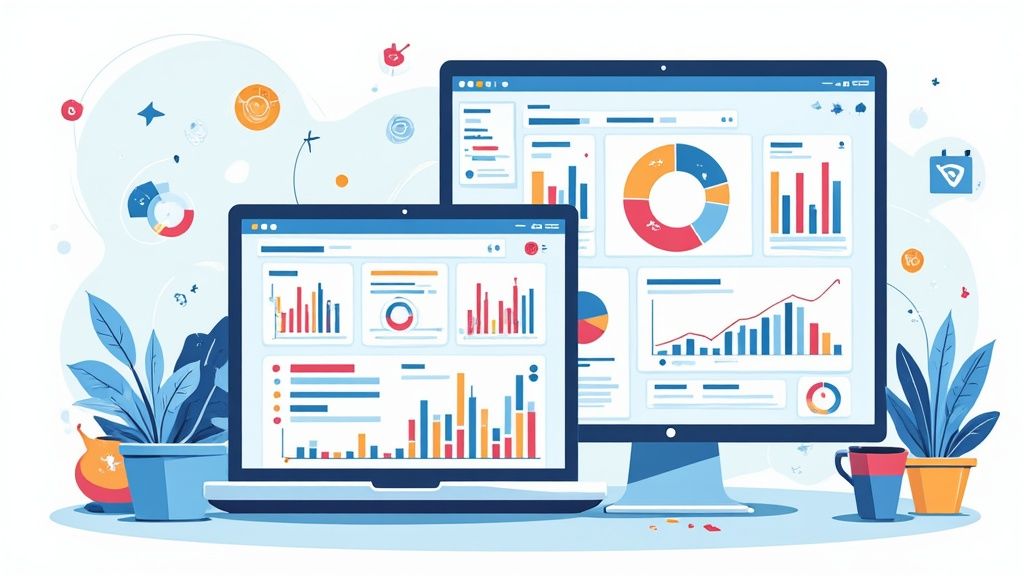The Ultimate Guide to Employee Productivity Tracking: Building Trust While Driving Results
Master employee productivity tracking with proven strategies that balance performance insights and team trust. Learn from industry leaders how to implement monitoring that motivates, protects, and delivers measurable business growth. meta t: The Ultimate Guide to Employee Productivity Tracking: Building Trust While Driving Results published: No slug: ultimate-guide-employee-productivity-tracking
The Evolution of Modern Productivity Tracking

The workplace has moved far beyond simple punch cards and paper timesheets. These basic tools focused only on tracking time spent at work, not actual productivity or output. Many managers found that employees could appear productive just by being present, even if they weren't accomplishing much. This limited view made it hard to understand how teams and individuals were really performing.
Remote work changed everything about how companies track productivity. With teams spread across different locations, old methods of tracking attendance no longer worked. This sparked rapid growth in digital monitoring tools, especially during COVID-19. By April 2020, the demand for employee monitoring software more than doubled as companies adapted to remote work. New tools emerged that could track everything from keyboard activity to screen recordings. You can find detailed data about this trend on Indeed Career Advice.
From Basic Timekeeping to Data-Driven Insights
Today's productivity software gives managers a complete picture of how work gets done. Modern platforms can track which apps employees use, how projects progress, and even analyze communication patterns between team members. This rich data helps companies spot trends and opportunities to work more efficiently.
The Rise of AI in Productivity Tracking
Artificial Intelligence (AI) and Machine Learning (ML) have added powerful new capabilities to productivity tracking. These tools can predict workflow bottlenecks before they happen and suggest personalized ways for each employee to work better. Instead of just watching what people do, AI helps understand how they work best and gives practical tips to improve.
Finding the Balance: Oversight and Autonomy
As tracking gets more sophisticated, companies face important choices about privacy and trust. The key is finding the right balance between useful oversight and employee independence. Good practices include: being open about what data is collected, focusing on team-level insights rather than constant individual monitoring, and clearly explaining how tracking information will be used. When done right, productivity tracking becomes a helpful tool that benefits both the company and its employees.
Building Employee Trust Through Transparent Monitoring
Trust and open dialogue are at the heart of successful employee productivity tracking. When companies openly discuss their monitoring practices rather than implementing them secretly, they create a more positive work environment. By clearly explaining what is being tracked, why it matters, and how the information will help the team, organizations can help employees see productivity tracking as a helpful tool rather than surveillance.
Open Communication: The Foundation of Trust
Starting new tracking systems requires careful planning and clear communication. Many successful teams begin with group discussions where managers explain the goals and benefits while giving employees a chance to ask questions and share concerns. Having written documentation that outlines exactly what will be tracked and how the data will be used helps prevent misunderstandings. When employees feel included in the process from the start, they're more likely to support and engage with it. You might be interested in: How to master productivity with Obsibrain.
Addressing Concerns Proactively
Many employees worry that tracking data could be used against them. The most effective organizations avoid this by focusing on employee development instead of punishment. This means using insights to identify training opportunities, provide targeted support, and recognize strong performance. When teams see productivity tracking as a way to grow and improve rather than a tool for criticism, they're more willing to participate constructively.
Data Transparency: Building a Culture of Mutual Trust
Sharing anonymous productivity trends with the whole team shows that tracking serves everyone's interests. Teams can spot workflow bottlenecks, identify what's working well, and make improvements together. Research confirms that most employees accept work-related tracking when the data is anonymized, though they prefer not to have personal time monitored. This points to the importance of finding the right balance. Learn more in the Workforce Trends Report.
Fostering a Growth Mindset
The best productivity tracking programs focus on learning and development. Regular check-ins allow managers to help employees understand their patterns, set meaningful goals, and measure progress. This creates an environment where everyone feels empowered to keep improving and contributing to the team's success. Rather than monitoring for monitoring's sake, tracking becomes a helpful tool for growth.
Performance Metrics That Drive Real Results

Good employee productivity tracking starts with picking the right metrics to measure. Rather than tracking every possible data point, focus on measurements that directly connect to your company's goals. This focused approach helps avoid overwhelming your team while giving you meaningful insights into what truly impacts success. When done well, it creates a positive environment where data guides improvement rather than criticism.
Key Metrics for Productivity Tracking
The best metrics to track depend on your team's work and specific objectives. For instance, sales teams often focus on leads and closed deals, while development teams might track completed sprints and resolved bugs. Here are some proven metrics worth considering:
Output-Based Metrics: Track concrete results like finished projects, sales numbers, or units produced to see exactly what each person and team delivers
Time-Based Metrics: Look at efficiency through measures like project completion speed, customer service response times, or time spent per task
Quality-Based Metrics: Check work quality using error rates, customer feedback scores, or number of revisions needed
Setting Realistic Benchmarks and Targets
After choosing your key metrics, you'll need to set reasonable goals based on past performance, industry standards, and individual capabilities. For example, if projects typically take three weeks, aiming for two and a half weeks gives teams an achievable target for improvement. This approach helps people stretch while staying motivated.
Keep in mind that productivity naturally varies over time. Workload changes, unexpected challenges, and personal circumstances all affect performance. Research shows that 48% of employees report being productive less than 75% of the time, highlighting why realistic expectations matter. Read more productivity insights at Time Doctor's workplace statistics.
Utilizing Data to Support Employee Growth
Remember that tracking productivity should focus on helping employees grow, not micromanaging their work. You might find helpful tips in this guide on mastering productivity. By analyzing performance data thoughtfully, managers can spot both strengths to build on and areas needing support. For example, if someone consistently struggles with specific tasks, the data can point to exactly what kind of training would help most. This creates a workplace where people get the support they need to do their best work.
Creating Ethical Monitoring Frameworks That Work
The rise of employee productivity tracking demands thoughtful planning to protect both business interests and worker privacy. Building monitoring systems that earn employee trust and deliver real business value requires going beyond minimum compliance requirements to create a genuinely ethical framework.
Transparency: The Cornerstone of Ethical Monitoring
Clear, upfront communication forms the foundation of ethical productivity tracking. When rolling out monitoring tools, organizations must explicitly share:
What data they collect
Why they need this information
How they will use and protect it
Showing employees how tracking helps spot workflow problems and boost team effectiveness makes the benefits clear. Giving workers access to their own data also builds trust by putting them in control of their information.
Data Security: Protecting Employee Information
Keeping employee data secure isn't optional - it's essential. Just as a bank vault protects valuables, organizations need strong safeguards around worker information, including:
Data encryption to prevent unauthorized access
Access controls limiting who can view sensitive data
Regular security reviews to check for vulnerabilities
Learn more about our approach to data protection in our Privacy Policy. With cyber threats growing more complex, staying on top of security is an ongoing commitment.
Empowering Employees Through Data Insights
The best monitoring frameworks help employees grow rather than just watch over them. When workers can see their own productivity patterns, they can:
Spot areas for improvement
Set personal development goals
Find and fix workflow bottlenecks
Take charge of their performance
This shifts tracking from a top-down control tool to a resource for personal and professional growth.
Striking the Right Balance
Creating ethical monitoring requires carefully weighing business needs against employee privacy. Focus tracking on metrics that directly connect to clear business goals, and avoid collecting unnecessary personal details. By limiting scope to what matters most, organizations can build trust while getting the insights they need. The right approach makes productivity tracking work for everyone.
Making Data Work For Your Team

While tracking employee productivity creates a lot of data, the real power comes from understanding and acting on those insights. Moving beyond just looking at numbers, successful companies actively use this information to boost performance. This means carefully studying trends, finding opportunities, and making smart changes that help both individuals and teams work better.
Making Sense of Your Data
The key to getting value from your data starts with picking the right metrics to track. For example, if you want happier customers, focus on measuring things like how quickly your team responds to issues and what percentage they solve successfully. This targeted approach prevents information overload and keeps everyone focused on what really counts.
Context matters too when looking at your numbers. If productivity drops, it might be because of a temporary project rush or outside factors affecting your team. Taking these situations into account gives you a clearer picture of what's really happening with performance.
Making Work Flow Better
Productivity tracking can spotlight where work gets stuck or slowed down. For instance, you might notice that a specific task takes much longer than expected. Once you spot these issues, you can fix them and free up time for more important work. The goal is to find and solve problems that keep coming up.
Good data also helps you give teams what they need to succeed. By seeing how people spend their time, you can provide better tools and support. This could mean buying new software, offering more training, or organizing teams differently to match people's strengths.
Helping People Grow
Productivity data isn't just for managers - it's a valuable tool for everyone's professional growth. When employees can see their own work patterns, they can spot ways to improve on their own. This openness builds trust and encourages people to take charge of their development.
You can use this information to create growth plans that make sense for each person. For instance, if someone consistently finds certain tasks challenging, you can arrange specific training or mentoring to help them improve. The key is using data to support and guide people, not to watch over their shoulders. When you focus on helping people grow, both the employees and the company benefit.
Future-Proofing Your Productivity Strategy

Work habits and productivity tools keep changing as new technologies emerge. To stay effective, companies need to update their approaches while keeping employee wellbeing in mind. Success comes from finding the right balance between adopting useful new tools and maintaining a people-first mindset.
The Impact of AI and Advanced Analytics
Artificial Intelligence is changing how we understand workplace productivity. AI tools can spot trends in how teams work and identify potential issues before they affect output. The technology provides specific suggestions to help each employee work more effectively based on their unique patterns and habits. Advanced analytics make it possible to measure productivity more accurately than ever before.
Embracing the Changing Workforce
The way people work has shifted dramatically with remote and contract work becoming common. This means old ways of tracking productivity based on time at a desk don't work anymore. Modern approaches need to measure actual results and value created, no matter when or where the work happens. Successful strategies focus on outcomes rather than just activity.
Building a Flexible and Adaptable Approach
Here are key ways to make your productivity strategy work for the long term:
Pick tools that grow with you: Choose systems that work with what you have and can handle new features as they come out
Put employees first: Make sure tracking is open and fair, helping people improve rather than just monitoring them
Let data guide decisions: Use productivity insights to make smart choices about teams, workflows and resources
Keep improving: Check regularly if your methods still work and update them based on results and feedback
Evaluating New Tools and Technologies
With so many productivity tools available, it helps to ask these questions when choosing:
Will this fit our culture? Tools shouldn't make people feel watched or controlled
Is it simple to use? Complex systems often create more problems than they solve
Does it give useful insights? Look for tools that explain what the data means and how to act on it
Can it handle growth? Make sure the solution will still work as your team expands
By following these guidelines, you can build a productivity strategy that benefits both your organization and your people.
Want to improve how your team tracks and manages productivity? See how Obsibrain can help your team work better together while maintaining transparency and trust.
Last updated
Was this helpful?